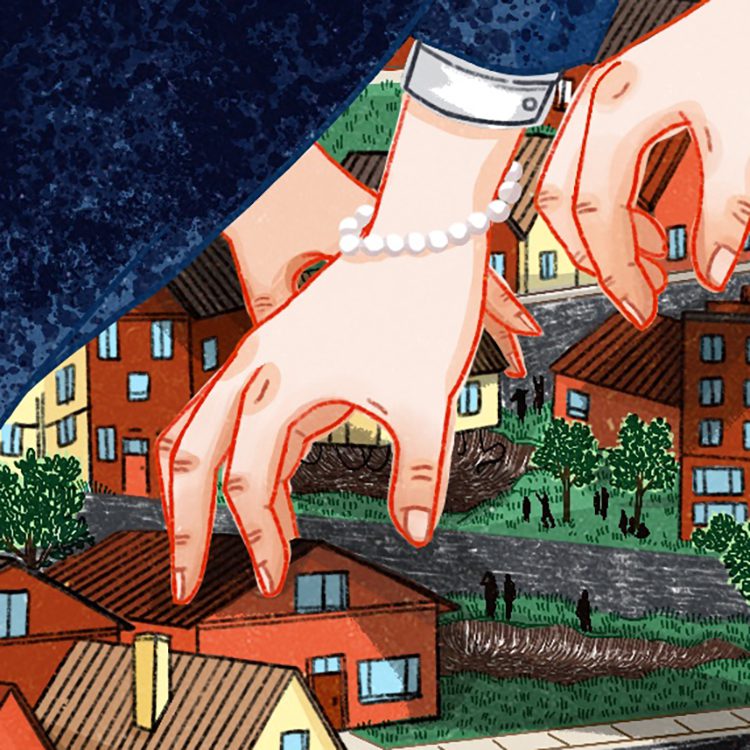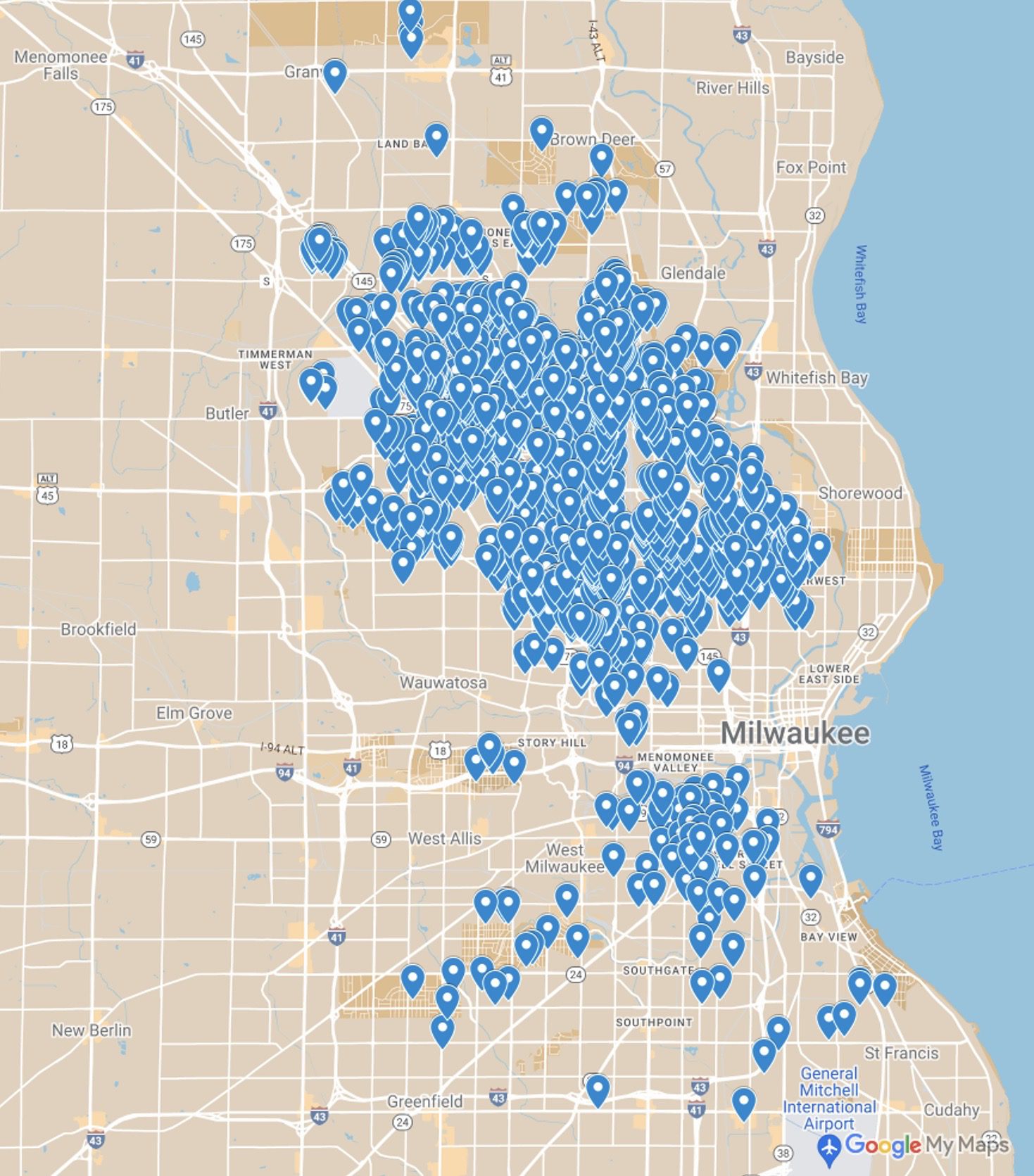This article is part of the Under the Lens series

Illustration by Lucy Engelman/ Resistance Communications
At first, the problem was just a broken light fixture in the kitchen. And the bathroom sink faucet that would pop off when turned. Amanda Hickman and her partner shrugged these off as the predictable aches and pains of renting an old apartment in San Francisco. But then California’s seasonal rain arrived. “We had a really heavy rainstorm and we had multiple buckets in the living room catching water that was falling in through the ceiling,” Hickman says. Repeated attempts to get the landlord to fix the ceiling went nowhere. Hickman knew it was time to go.
But something bigger than losing her deposit gnawed at Hickman as she made plans to relocate to a more hospitable place. “There were elderly tenants living in rent-controlled apartments in the building who had been there for many years,” Hickman recalls. “One of them, this old Russian guy, told me about how his sink had caved in and the landlord hadn’t fixed it, so he just didn’t have a sink. And I thought, ‘We can afford to move’ but a lot of these other tenants couldn’t.”
Using her own experience and records from the city of San Francisco’s Department of Building Inspection website to document the landlord’s pattern of negligence, Hickman took her landlord to court. But pursuing accountability soon became very heavy lifting. As an individual taking on an errant property owner of several apartment buildings across the city, Hickman had to file a sheaf of claim forms in person and take entire days off of work to attend court hearings. When a judge ruled that Hickman’s landlord owed her money for the months when the apartment was unlivable, the landlord reacted by taking Hickman to small claims court on allegations that her dog had been too noisy. (“We were like, “OK . . . all of this is brand new to us!’” Hickman said.)
When all was said and done, Hickman moved out, got her deposit back, and was awarded a modest amount of damages. But her landlord still remained at large, ruffled but not reined in by this unusual instance of accountability.
The Slumlord Issue
Most of us know someone who’s been in Hickman’s position—living at the mercy of a landlord who racks up code violations as if they were parking tickets, allowing their property to fall into disrepair and dismissing their tenants’ requests for maintenance, even when safety is a concern. Property owners who display this pattern of behavior have long been called “slumlords” and as the cost of rent in American cities keeps skyrocketing mid-pandemic, partially due to a shortage of rental housing, cities and states are going after some of the most prolific offenders. Or at least trying to help some of their belabored tenants and spotlighting the slumlord issue.
In New Orleans, the city is busy relocating renters from the 336-unit Algiers complex, which fell into bankruptcy and has since festered with mold, insects, and raw sewage. Tenants from 27 rental units in Wilmington, Delaware, had to finding other housing suddenly when the city condemned their landlord’s property due to deteriorated bricks and floor joists that the landlord had ignored. And in Tampa, Florida, Democratic gubernatorial candidate Nikki Fried lambasted the owners of Silver Oaks Apartments, where the tenants have endured plumbing issues and lots of rodents. “Florida renters are being taken advantage of,” Fried told reporters at a press conference outside the apartment complex. “Here at Silver Oaks Apartments . . . management has flouted not just the federal rules but the rules of common decency and respect.”
The “federal rules” that Fried refers to are presumably the Section 8 housing quality standards outlined by HUD, which landlords must meet in order to be eligible to participate in the federal voucher program. (The renters at Silver Oaks Apartments are lower-income tenants, and the complex has received federal subsidies.) In theory, if a landlord’s property fails a Section 8 inspection conducted by their local housing authority on behalf of HUD, they can get cut off from the program. But when it comes to putting pressure on unsubsidized private landlords to make much-needed repairs to their properties, states and cities are often left to their own devices. This can leave tenants vulnerable to local legislatures, which are most influenced by real estate lobbying groups. (The largest of these groups, the National Association of Realtors, spent more than $84 million in 2020 in a bid to get the CDC’s nationwide eviction moratorium scrapped.) But limited federal involvement in the matter of housing conditions can also leave local governments with more leeway to come up with bold ideas for cracking down on bad landlords. For instance: what if instead of just forcing a landlord to make repairs, you could also cut them off from acquiring and renting more properties?
The Crackdown That Never Came
In 2017, one of the largest landlords operating in Washington, D.C., was Bethesda-based Sanford Capital, which owned and managed more than 65 buildings across the city region. Investigative reporting by the Washington City Paper had exposed Sanford’s business strategy of acquiring properties with lower-income tenants and knowingly allowing the properties to fall into unlivable squalor that would force the tenants to move out, clearing the way for refurbishing the neglected units and renting them at market rates. As the city council caught wind of the horrors endured by Sanford Capital tenants—roach infestations, sweltering indoor temperatures, hospitalizations likely caused by poor ventilation—six council members hatched a new idea for taking action against bad actors like Sanford Capital: go after their business licenses and building permits.
The Slumlord Deterrence Amendment Act of 2017 was introduced by nearly half of the 13-person D.C. city council, and its central provision was simple yet powerful. The law would deny landlords the ability to expand their property portfolios if they refused to maintain their properties. The city would enforce this by taking away the defiant landlords’ business licenses and building permits until they performed the outstanding maintenance. It was an unusual piece of legislation targeting bad landlords, in that it engaged with the problem at a systemic level instead of just reacting to the negligence of property owners once damage had been done.
But it didn’t take long for the Slumlord Deterrence Act to run headlong into two obstacles—the political power of landlords, and the technical question of how the city could actually enforce it.
Joe Schilling, a senior research associate with the Urban Institute, is intimately familiar with how landlords assert their influence over local legislatures. During the 1980s, Schilling served as the deputy city attorney of San Diego and spent much of his time prosecuting the landlords with mountains of code violations. As he’s seen it, forward-thinking legislation that aspires to deter landlords from neglecting their rental property has a way of triggering the landlord community’s gut aversion to government and beefed-up regulatory policy. “[Landlords] may support slumlord task forces because it’s going against the bad actors,” Schilling says. “But then if a city wants to go upstream and try to prevent substandard apartments from happening by adopting a proactive rental inspection ordinance, that’s ‘going too far.’ We have to remember that like the Second Amendment, property rights are still one of the hot-button political issues in the United States.”
As an illustration of the power of the landlord lobby, Schilling points to a more recent story in Virginia, where Republican Gov. Glenn Youngkin vetoed a bipartisan bill from the state legislature that would have allowed municipalities to take direct legal action against landlords who don’t respond to code violations within a reasonable time frame. (The penalties here could range from court-ordered property repairs to being held in contempt of court and doing jail time.) In his veto, Youngkin rejected the notion that landlords needed more regulatory oversight from the state, arguing instead that “landlords and tenants both have responsibilities to maintain safe, decent, and sanitary housing.” It’s easy to imagine how Youngkin might have responded to a more aggressive piece of regulatory legislation aimed at landlords, like the Slumlord Deterrence Act.
But even if local legislatures were less beholden to the real estate lobby, another factor that makes it harder for cities and states to crack down on bad landlords is simply knowing which landlords own which properties and are thereby responsible for their upkeep. In 2018, Anne Cunningham, an attorney with the Children’s Law Center (which represents tenants) testified before the D.C. city council on the strengths and shortcomings of the Slumlord Deterrence Act. One of the bill’s flaws was its enforcement mechanism. It would prevent only the specific LLC involved with outstanding code violations from expanding its property ownership, which could be quite limited, because landlords will often set up a new LLC for every property that they own. “Unfortunately, there is no current mechanism for determining who owns an LLC in D.C.,” Cunningham said in her testimony. “[The Slumlord Deterrence Act] must include a component mandating disclosure of all individuals and businesses with an ownership interest in an LLC.”
Cracking the Data Window
Hiding behind LLCs has become a proven self-protection strategy for bad landlords. Only a few decades ago, it was common for most rental properties to be listed under the name of individual landlords. But since the mid 2010s, the liability protections offered to landlords by establishing an LLC have made it easier for rental property owners to shield themselves from scrutiny, making housing markets less transparent. (Some investigations into the matter have outed celebrities who quietly add to their already lucrative incomes by landlording, including Fox News host Sean Hannity and married actors Kristen Bell and Dax Shepard.) In New York, the practice became so rampant that in 2019, the state enacted a law that requires any LLC dealing in residential real estate to disclose all of its members’ names. Similar laws have been applied in a handful of other states, such as Arizona and Washington.
Leveraging data transparency to help tenants and hold landlords accountable is something that Angela Lee Stovall and Sam Rabiyah think about constantly. Both are part of the team behind JustFix.nyc, a New York-based nonprofit that offers a free digital tool called Who Owns What, which tenants and policymakers can use to find out who owns which properties. According to Rabiyah, a data lead and engineer, part of the impetus behind creating Who Owns What and the additional JustFix tools (which assist tenants with tasks like sending a certified letter requesting repairs) was offering renters and their advocates a way to assert some power. “The idea behind JustFix was that technology should be a tool that is available and accessible to people who are embedded in the tenant movement and are doing more of the grassroots work fighting against displacement and gentrification in New York,” Rabiyah says, adding that the Who Owns What tool offers the benefit of a more user-friendly experience than combing through the New York Department of Finance’s tax and property registration records, searching for data on landlords.
Stovall—a research and policy manager—was introduced to Who Owns What through her work in tenant rights and city government. She provided legal services for tenants involved in eviction defense cases in a Queens housing court before joining up with the New York City Commission on Human Rights and working on discrimination cases involving prospective renters with housing vouchers. “In 2019, the NYC Human Rights Law had this jurisdictional requirement where we could only intervene in instances when the landlord owned a building of six or more properties within NYC,” Stovall says. “With JustFix … we could see how large a landlord’s portfolio was, where their buildings were concentrated, or … if an apartment wasn’t available, did [the landlord] have something else they could have offered a person that was within their payment standard?”
Since the launch of the JustFix tools, Stovall and Rabiyah have seen landlord data being used by housing advocates, policymakers, and even financial institutions. In 2021, the JustFix team and the Right to Counsel NYC Coalition released a data-driven list of New York landlords who had sued the most tenants for eviction during the COVID-19 crisis. “The Department of Housing Preservation and Development was actually cited as one of the sources of funding for a certain portfolio that landed on the list, so they reached out to us to investigate that,” Rabiyah says. “We also had banks listed as lenders for some landlords reach out to us as they used data to gauge reputational risk—to decide whether it’s unsafe to provide funding for these landlords on the list.”
If data transparency can be tapped by local governments seeking to identify the patterns of bad behavior by certain landlords, meaningful regulatory policies aimed at the worst actors could become more tangible. A proposal like D.C.’s Slumlord Deterrence Act, aimed at the portfolios of negligent landlords, could have teeth and be enforceable. If jurisdictions shared data, and bills were worded to include violations in any property they own, in theory a bad actor could even be prevented from getting a foothold in a new area, even if the location of their existing properties isn’t holding them accountable.
Politically, any such regulation will still be an uphill battle, given the imbalance of lobbying power between landlords and tenants. But that historic imbalance is slowly improving as tenants across the U.S. build more power through organizing, preventing evictions, and pressuring local lawmakers to pass policies such as Tenant Opportunity to Purchase acts. If financial institutions that have funded bad landlords can be persuaded to think about cutting off these property owners out of concern for their own reputations, perhaps more lawmakers and even upstanding landlords could be similarly persuaded to change their minds about stronger regulatory policy.
Good Landlords
Barbara Parmenter became a landlord by happenstance. When she and her partner inherited a two-family house in the suburban Boston neighborhood of Brighton, they rented the second unit to tenants, prioritizing trust and longevity over rental profit. It’s a setup commonly encountered in owner-occupied rental properties, where a landlord might entice reliable tenants to stay put for several years by keeping the rent stable and the property well-maintained. But this best-case scenario for tenants is not widespread enough, as Parmenter realized during the pandemic while volunteering for local schools that had closed and dropping off lunch cartons to students around Brighton.
“What I’ve seen in our community with really poor landlord maintenance, it’s shocking to me,” Parmenter says. Her delivery route included both public and private housing units, and it was the state of the private rental stock that left Parmenter aghast. “Doors were stuck, windows were broken, and there were porches with balconies sagging,” Parmenter recalls. “One person I talked to, her stove hadn’t worked in months.”
For her part, Parmenter would like to see the city of Boston enact substantive regulatory policy aimed at curbing the exploits of the most negligent local landlords—not just out of empathy for tenants, but also out of collegiality and pragmatism. “Most of the houses around mine are rental properties and I’m lucky that these landlords are people who are taking care of things, people who I can call up when there’s a problem,” Parmenter says. The looming question is, how many other landlords think like this? How many could be vocally supportive of regulatory policies like D.C.’s Slumlord Deterrence Act that would separate the good actors from the bad ones? And could some cities even join forces with these landlords in pursuit of their regulatory projects?
There might not be much of a precedent for coalition-building between cities and landlords, but Urban Institute’s Joe Schilling is quick to identify an example of what a constructive partnership like this could look like. In several U.S. cities, local governments offer landlords the chance to participate in good landlord programs. The city outlines criteria by which any “good landlords” should abide (for example, responding promptly to tenants’ maintenance requests) and the city offers landlords resources and training to help them meet the criteria. In doing so, landlords can earn perks like discounted municipal service fees while building their capacity. “These programs are really targeted at quintessential mom and pop landlords who may be acquiring or inheriting a few properties,” Schilling explains. “They hit a certain number and suddenly they get overwhelmed by the regulatory requirements.”
Good landlord programs can be the means for a great variety of ends, not all of which might be considered “good” by tenant advocates. In Utah, good landlord programs aimed at increasing safety have made it tougher for people who have been incarcerated to find housing by, for example, including not renting to people with a record as one of the desirable practices. But at its core, the model has led to some landlords working productively with their local governments to uphold standards—a notable break from the long history of landlords bristling at the first mention of new regulatory policies. And as Schilling sees it, meaningful action against the most irresponsible, ill-motivated landlords shouldn’t just involve a crackdown. “To address the issue of substandard housing, it shouldn’t be all carrots, but it can’t be all sticks,” Schilling says. A policy that offers landlords clear incentives for establishing themselves as good actors in the eyes of the city government could help isolate and spotlight the worst landlords, leaving them less able to rally support for fending off stronger measures—possibly even ones that limit their ability to buy more buildings.
|
|





Comments